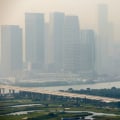As an expert in environmental policy and regulation, I have dedicated years to studying the impact of the Clean Air Act on air pollution in the United States. While the EPA has made significant strides in controlling common pollutants and hazardous toxins, there are still major flaws in the implementation of this legislation that must be addressed. One of the main issues with the Clean Air Act is its focus on monitoring and creating policies for large air districts. While this approach has been effective in some areas, it often overlooks smaller, heavily affected regions known as “hotspots” of air pollution. The standards set by the Clean Air Act are based on averages collected over large population areas, which may not accurately reflect the air quality in these hotspots. Furthermore, it is possible that the drafters of the Clean Air Act did not fully rely on air quality standards and state plans as a mechanism for reducing emissions.
This hesitation to fully commit to these measures may have been a way to avoid potential backlash from industries and states. However, after 50 years since its inception, it is clear that this type of indefinite exemption is not effective from an efficiency standpoint. In fact, my team and I have compared two approaches that reflect the main aspects of the Clean Air Act and a third approach that is not commonly used. Our findings show that this third approach would be more effective at addressing disparities in adjoining areas of the country. The Clean Air Act has undoubtedly played a crucial role in improving air quality in the United States. But despite these improvements, people of color at all income levels are still disproportionately exposed to higher-than-average levels of air pollution.
This is a major concern, especially when considering recent news about the drastic shortening of average life expectancy due to respiratory illnesses caused or exacerbated by air pollution. Before the Clean Air Act was enacted in 1970, industrial facilities were allowed to pollute the country's air with little regulation. This led to an increase in cases of respiratory illnesses such as emphysema and asthma. However, thanks to the Clean Air Act, we have seen a significant improvement in air quality, which has not only improved visibility and reduced the risk of acid rain but also helped protect the ozone layer. But there is still room for improvement. One of the main criticisms of the Clean Air Act is that it relies too heavily on national air quality standards and state implementation plans to reduce emissions.
This approach may not be enough to effectively combat air pollution, especially when it comes to fine particle pollution, also known as PM2.5.These particles are less than 2.5 micrometers in diameter, making them approximately 3% of the diameter of a human hair. In recent years, there has been a growing demand for stricter air quality standards to mitigate health risks, combat the climate crisis, and support economic growth. This is a clear indication that the Clean Air Act needs to be updated and strengthened to better protect public health and the environment.










